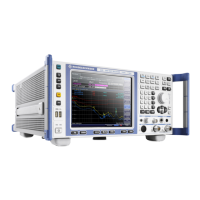Quick Start
R&S
®
ESR
131User Manual 1175.7068.02 ─ 12
END SUB
REM ***********************************************************************
Frequency Counting
The following example is based on a signal at 100 MHz with a level of -30 dBm. Again,
the instrument's default setting can be used (SetupInstrument). The purpose of fre-
quency counting is to determine the exact frequency of the signal at 100 MHz.
REM *************************************************************************
Public Sub MarkerCount()
Dim retCount as Long
CALL SetupInstrument 'Default setting
'--------- Defining signal frequency with frequency counter ----------------
CALL InstrWrite(analyzer,"INIT:CONT OFF")
'Switch to single sweep
CALL InstrWrite(analyzer,"CALC:MARK:PEXC 6DB")
'Define peak excursion
CALL InstrWrite(analyzer,"CALC:MARK:STAT ON")
'Activate marker 1
CALL InstrWrite(analyzer,"CALC:MARK:TRAC 1")
'Set marker 1 to trace 1
CALL InstrWrite(analyzer,"CALC:MARK:X 100MHz")
'Set marker 1 to 100 MHz
CALL InstrWrite(analyzer,"CALC:MARK:COUNT ON")
'Activate frequency counter
CALL InstrWrite(analyzer,"INIT;*WAI") 'Perform sweep with sync
CALL InstrWrite(analyzer,"CALC:MARK:COUNT:FREQ?")
'Query and read measured frequency
result$ = Space$(100)
CALL InstrRead(analyzer, result$, 100, retCount)
Debug.Print "Marker Count Freq: ";result$
END SUB
REM *************************************************************************
Working with a Fixed Reference Point
The following example is based on a signal at 100 MHz with a level of -20 dBm. Thus,
the harmonics of the signal are located at 200 MHz, 300 MHz, etc. For high-quality sig-
nal sources, these harmonics may be located outside the dynamic range of the
R&S ESR. Nevertheless, to measure the harmonic suppression, the level setting must
be changed to higher sensitivity when measuring the harmonics. In this case, it may be
necessary to suppress the carrier by using a notch filter in order to prevent the RF
input of the R&S ESR from being overloaded.
Thus, two measurements with different level settings are performed in the following
example. First, a high reference level is used on the carrier frequency, and then a low
reference level is used on the frequency of the third harmonic.
The default setting of the R&S ESR for measurements ("SetupInstrument") is also
used as a starting point here, after which adaptations for the measurement are carried
out.
Brief Introduction to Remote Control

